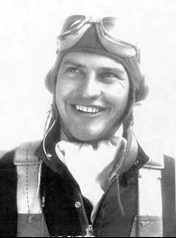Two alerts before daylight. War started. Had patrol about noon. Moved to C.F. just before dark. C.F. bombed to hell and while we were patrolling over N.F. No air defense at C.F. Complete surprise.
At about 11:45, Dyess had received a phone call ordering him to take his squadron to Clark Field. A and B Flights took off, but C Flight–led by Bob Clark–was delayed in getting off due to engine difficulties and was unable to locate the other two flights. Evidently Burns was flying with A or B Flight rather than his C, for some unknown reason. As Dyess led A and B Flights to Clark, he received a radio call from 24th Group operations to turn around and return to the Manila area, where he was to await Japanese bombers expected from the west to attack Manila. In the meantime, the P-40Es of Bob Clark and his wingman Jimmy May–not yet completely slow-timed–were throwing oil on their windscreens and the two were obliged to return to Nichols, with Sam Grashio taking over the flight. Not having picked up the call from Group, Grashio led the four to Clark Field, where they ran into the Japanese attack on the field that began at 12:35. A and B Flights patrolled over Manila area–as did the three flights of the 17th Pursuit–and did not encounter any Japanese bombers, a group of which–53 Bettys–had hit Iba Field on the west coast at 12:40 while the other group of 53 (Bettys and Nells) bombed Clark.
At 5:30 p.m., the 17th and 21st Squadrons received orders to shift their aircraft up to Clark Field, a runway there reportedly in good enough shape for landings. The 21st flew up its 18 remaining operational ships in a group with the 17th Pursuits. Those of Joe Cole, Bob Clark, Jimmy May, and Sam Grashio were left behind.
